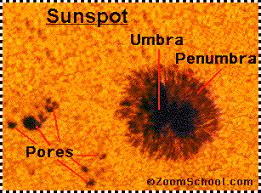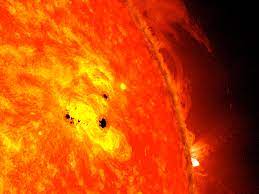- Two massive swarms of sunspots have appeared on the sun's surface, indicating that there will be more vivid auroras and potentially damaging solar flares in the months ahead. Some sunspots are so massive that they could swallow the entire Earth.
The new sunspot groups, known as "active regions" 2993 and 2994 (AR2993 and AR2994), appear to be followed by a third sunspot group, which is still hidden beneath the sun's northeastern limb (or apparent edge) and looks to have triggered a large solar flare that passed Earth a few days ago.
Each swarm is made up of many sunspots that encompass hundreds of millions of square miles – an extent significantly larger than the circumference of the Earth. They're created by magnetic instabilities in the sun's visible photosphere, which expose the sun's colder layers underneath the visible photosphere.
Magnetic entanglements and disentanglement on the sun occur in 11-year cycles, with low and high activity phases in each cycle. Since 1775, when extensive recording of sunspot activity began, solar activity cycles have been numbered. We are currently in Solar Cycle 25, which has not yet reached its apex, implying that there will be more sunspot activity in the future.
Solar physicist Dean Pesnell of NASA's Goddard Space Flight Center said, "I'm confident we'll see greater [active zones] over the next few years."
"Active areas 2993 and 2994 are of average size and do not reflect the best of Solar Cycle 25."
According to Pesnell, the present cycle is likely to peak in late 2024 or early 2025. Radiation (solar flares) and coronal mass ejections (CMEs), which are super-hot plasma balls, are two ways that energy from active regions might be released.
Solar flares and CMEs can produce magnificent auroras, but they can also pose a threat to power grids, satellites, communications networks, and even space travelers who are not protected by the Earth's magnetic field.
Solar Cycle 25
The sun has already been quite active over the last three weeks, according to Jan Janssens, a communications specialist at the Solar-Terrestrial Centre of Excellence in Brussels, and there is no indication that it will become less active very soon.
Last week, the Earth narrowly avoided a solar plasma ejection associated to a far older sunspot group.

"As the solar cycle approaches its maximum, more complex sunspot patches become apparent, potentially resulting in solar flares."
According to records, solar activity is currently roughly the same as it was during the previous solar cycle, and even lower than it was at this time during the two solar activity cycles before that, he said.
A large class X1.1 flare detected on Sunday (April 17) now appears to be from a third sunspot group spinning behind AR2993 and AR2994 onto the visible disk of the sun, according to Pesnell, who is also the project scientist for NASA's Solar Dynamics Observatory.
According to NASA, solar flares are classified into five classes, each ten times more intense than the one before it - A, B, C, M, and X. The most powerful X-class flares can carry more than ten times the power of an X1 flare, meaning there's no limit to how huge they can get – the most powerful on record, in 2003, overwhelmed the sensors at X28.
The National Oceanic and Atmospheric Administration's (NOAA) Space Weather Prediction Center stated that an X-ray pulse from Sunday's X1 flare triggered a significant blackout at radio frequencies below 30 MHz spanning Southeast Asia and Australia.
However, it was found that the CME of star material produced by the most recent solar flare will not reach Earth.

When CMEs strike the Earth, however, they can have devastating consequences, such as overloading electricity grids or disrupting radio communications, or even injuring astronauts in space. They can also inflict direct damage to satellite electronics and heat the gases in the upper atmosphere, increasing drag on low-orbit satellites.
"Over the next few years, flares and coronal mass ejections will become more common, enhancing the risk level of solar activity," Pesnell predicted
So far, the contemporary world has escaped the worst effects of solar storms, and power grid operators are increasingly "hardening" their technology to withstand such disturbances.
However, during the "Halloween storms" of 2003, some of the worst solar flares in recent memory knocked down power in areas of Europe and South Africa for several hours.



You must be logged in to post a comment.